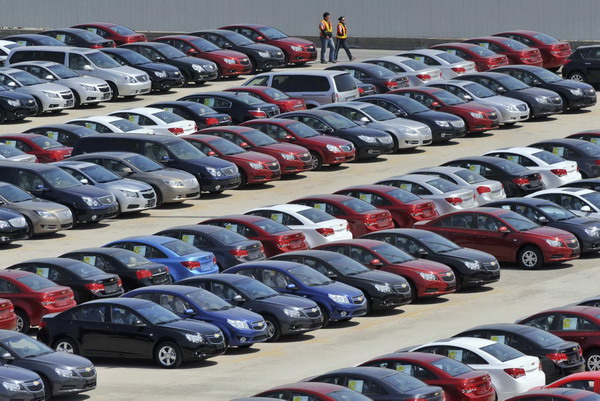
Indeed, according to Socia, GM and SAIC might take the same business model - combining their respective strengths to crack emerging market demand for no-frills cars - to Southeast Asia.
"The whole ASEAN arena is ripe for that same sort of conversation," Socia said, referring to the Association of Southeast Asian Nations, a 10-country grouping that includes Malaysia, the Philippines, Singapore and Malaysia.
Of the fast-growing markets inside ASEAN, GM and SAIC are particularly interested in Indonesia and Thailand, Socia said.
Southeast Asia has long proven a tough market for GM and other western auto makers in part because it is dominated by Japanese auto makers.
In Indonesia, where Japanese brands control well over 90 percent of a market expected to generate 1 million car sales this year, GM is just re-starting local production.
|
 File photo of General Motors' new Chinese-made cars for domestic and foreign markets seen at a parking lot in Shenyang, Liaoning province. [Photo/Agencies] |
In the second quarter of next year, it plans to reopen an assembly plant near Jakarta, which it closed down in the mid-2000s. It sold 4,624 cars in Indonesia in the first 11 months of this year.
"It's not that we cannot do it by ourselves," Socia said. "We are studying all sorts of options," including joining forces in Indonesia with SAIC.
That's mainly because GM wants to offer more products at bargain-basement prices. GM has not announced pricing for the Spin, a small car it plans to produce in Indonesia, but Socia said the boxy people mover is "the type of product that we think could do well" in the country.
"But again you really have got to find that value proposition point" in order to compete with the Japanese and make inroads in Southeast Asia, he said.
So, as in India, GM is likely to use the Wuling brand of no-frills microvans it jointly produces and markets in China with SAIC to try to crack the Southeast Asia market.
Many of those workhorse vans, which can also be used as private cars, sell for as little as 30,000 yuan and could be the model frugal emerging middle-class buyers are looking for in Indonesia and elsewhere, Socia said.
As further evidence of GM and SAIC's close relationship, Socia said the two companies are now buying more car components "together than ever before" to achieve cost savings from purchasing in greater volumes.
The two companies also just opened a new plant in the southern Chinese city of Liuzhou, where the Wuling brand is headquartered, and intend to open another plant in the southwest city of Chongqing to produce low-cost microvans.
"The relationships that we have with our partners I think are very good," Socia said, referring to SAIC.
Socia said GM expects China's demand for passenger cars and commercial vehicles to finally climb above 20 million next year.
The overall market will likely grow "5 to 8 percent" in 2013 to 21 million vehicles, a GM estimate shows. Socia said overall car sales should total 19.4 million to 19.5 million this year.
Related readings:
GM's China research center to focus on 'new energy'
SAIC sheds most of its share in GM India JV
GM's China JV invests 6.6b yuan to set up new plant
US auto giants see sales surge in October